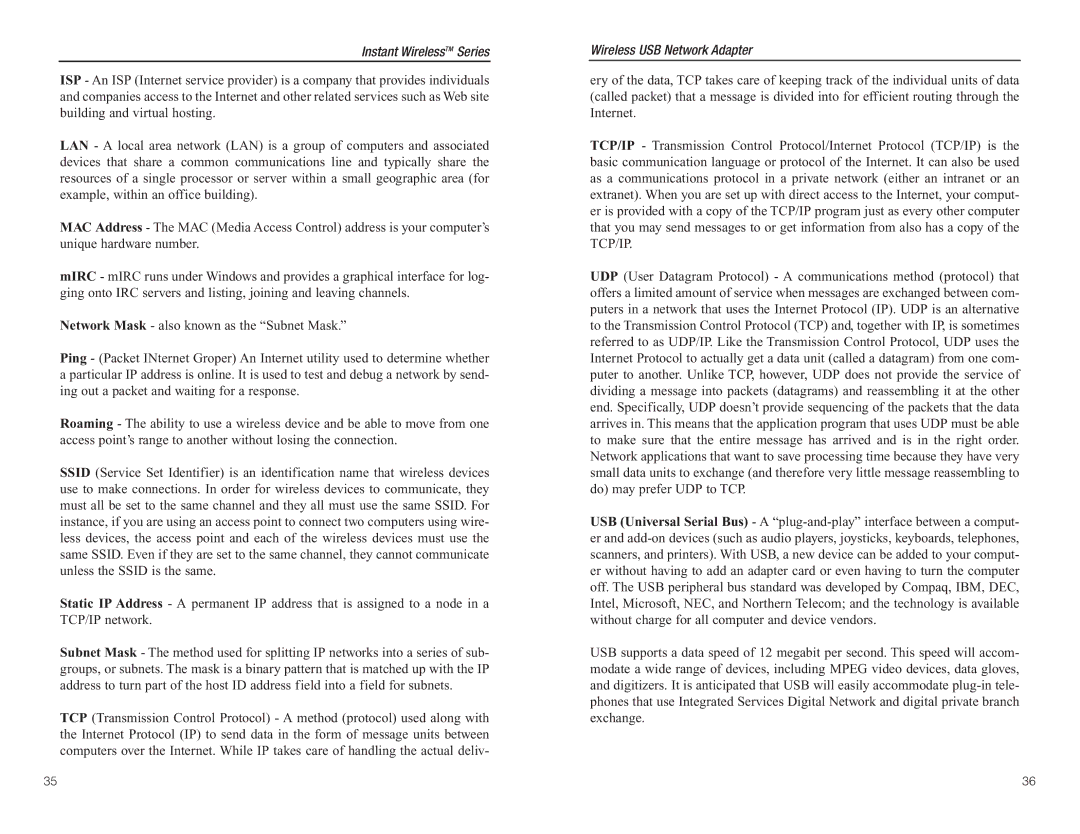Instant WirelessTM Series
ISP - An ISP (Internet service provider) is a company that provides individuals and companies access to the Internet and other related services such as Web site building and virtual hosting.
LAN - A local area network (LAN) is a group of computers and associated devices that share a common communications line and typically share the resources of a single processor or server within a small geographic area (for example, within an office building).
MAC Address - The MAC (Media Access Control) address is your computer’s unique hardware number.
mIRC - mIRC runs under Windows and provides a graphical interface for log- ging onto IRC servers and listing, joining and leaving channels.
Network Mask - also known as the “Subnet Mask.”
Ping - (Packet INternet Groper) An Internet utility used to determine whether a particular IP address is online. It is used to test and debug a network by send- ing out a packet and waiting for a response.
Roaming - The ability to use a wireless device and be able to move from one access point’s range to another without losing the connection.
SSID (Service Set Identifier) is an identification name that wireless devices use to make connections. In order for wireless devices to communicate, they must all be set to the same channel and they all must use the same SSID. For instance, if you are using an access point to connect two computers using wire- less devices, the access point and each of the wireless devices must use the same SSID. Even if they are set to the same channel, they cannot communicate unless the SSID is the same.
Static IP Address - A permanent IP address that is assigned to a node in a TCP/IP network.
Subnet Mask - The method used for splitting IP networks into a series of sub- groups, or subnets. The mask is a binary pattern that is matched up with the IP address to turn part of the host ID address field into a field for subnets.
TCP (Transmission Control Protocol) - A method (protocol) used along with the Internet Protocol (IP) to send data in the form of message units between computers over the Internet. While IP takes care of handling the actual deliv-
Wireless USB Network Adapter
ery of the data, TCP takes care of keeping track of the individual units of data (called packet) that a message is divided into for efficient routing through the Internet.
TCP/IP - Transmission Control Protocol/Internet Protocol (TCP/IP) is the basic communication language or protocol of the Internet. It can also be used as a communications protocol in a private network (either an intranet or an extranet). When you are set up with direct access to the Internet, your comput- er is provided with a copy of the TCP/IP program just as every other computer that you may send messages to or get information from also has a copy of the TCP/IP.
UDP (User Datagram Protocol) - A communications method (protocol) that offers a limited amount of service when messages are exchanged between com- puters in a network that uses the Internet Protocol (IP). UDP is an alternative to the Transmission Control Protocol (TCP) and, together with IP, is sometimes referred to as UDP/IP. Like the Transmission Control Protocol, UDP uses the Internet Protocol to actually get a data unit (called a datagram) from one com- puter to another. Unlike TCP, however, UDP does not provide the service of dividing a message into packets (datagrams) and reassembling it at the other end. Specifically, UDP doesn’t provide sequencing of the packets that the data arrives in. This means that the application program that uses UDP must be able to make sure that the entire message has arrived and is in the right order. Network applications that want to save processing time because they have very small data units to exchange (and therefore very little message reassembling to do) may prefer UDP to TCP.
USB (Universal Serial Bus) - A
USB supports a data speed of 12 megabit per second. This speed will accom- modate a wide range of devices, including MPEG video devices, data gloves, and digitizers. It is anticipated that USB will easily accommodate
35 | 36 |
